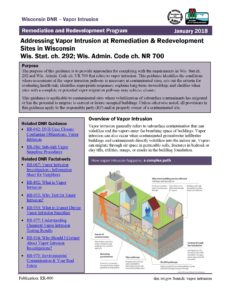The RR Program seeks your input on a revised, draft publication entitled “Clean Soil Management: A Self-Implementing Option for Soil Excavated During a Response Action under Wis. Admin. Code §§ NR 700 through NR 750” (RR-103). This draft guidance was revised based on comments received from the public. This revision is much narrower in scope than the last version that was sent out for public comment. This guidance is different than, but related to, the NR 718 contaminated soil guidance.
In particular, this guidance is intended solely for use by responsible parties (RPs) who are managing soil excavated as part of a response action pursuant to Wis. Stats. ch. 292 and Wis. Admin. Code chs. NR 700 – 754.
The guidance does not apply to soil excavated as part of a construction project, utility project or transportation project. However, if those projects also involve an NR 700 response action, this guidance only applies to the soil excavated as a direct result of the response action.
This draft guidance provides an optional approach for responsible parties and their environmental consultants to use when soil is characterized and excavated as part of a response action (i.e., cleanup action), and the soil does not need to be managed at a licensed solid waste facility or through a site-specific exemption in Wis. Admin. Code chs. NR 718 or the NR 500 rule series. This document provides responsible parties (RPs) more clarity on what types of substances – if identified in soil – could generally be managed as “clean soil” in accordance with state law without the department’s pre-approval or tracking. However, the person placing or accepting the soil would need to comply with limited locational criteria. The department believes that providing this guidance will help responsible parties and their environmental consultants to save money, and make more timely and consistent decisions on how to manage this type of excavated soil during a Wis. Admin. Code ch. NR 700 cleanup action.
The document can be reviewed at http://dnr.wi.gov/news/input/guidance.html and comments can be submitted through May 13, 2018 to the Brownfields and Outreach Section Chief, Christine Haag at Christine.Haag@wisconsin.gov. In addition, the RR Program will host a question and answer session on this guidance scheduled for April 20, 2018, at 10:30 a.m. Meeting logistics and agenda can be found on the DNR’s public meetings calendar (dnr.wi.gov search “public meetings”). Externals are encouraged to provide written comments, as formal note taking will not capture comments during the listening session. Please note: Attendees must check-in at the visitors desk on the first floor. A conference call number is also available. Please RSVP to Christine Haag (christine.haag@wisconsin.gov) if planning to attend.

